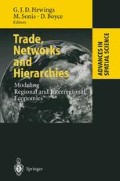Abstract
The 1980s and early 1990s were a time of profound restructuring in the Midwest. The region had stood as the nation’s wealthy and progressive manufacturing center for a long-standing century. But the confluence of shocks that took place during this time shook the region’s economy to its foundations—defense spending shocks, farm crisis, foreign competition, and technological change. In turn, these shocks challenged the region’s businesses and policymakers to either change course or to wither away. By the mid-1990s, there was very visible evidence — both statistical and otherwise — that the region had been successful in its transition well beyond the hopes and expectations of majority opinion. Indeed, some observed that such a renaissance was probably unique in the annals of those regions experiencing deep manufacturing decline and decay in the industrial age... so much so that the Midwest’s experiences merited a deeper analysis and understanding as a guide to policy makers both in the Midwest and elsewhere. In cooperation with many analysts drawn from an array of organizations, the Federal Reserve Bank of Chicago organized a two-year project to bring together the best researchers and their work to address the Midwest turnaround. Over the course of the many topical symposiums, it became apparent that the project was fortunate in its inquiries because crucial tools to understand the Midwest turnaround and to guide its policy decisions were under development by the Regional Economics Applications Laboratory (REAL) and its directors—Philip Israilevich and Geoffrey Hewings.
Access this chapter
Tax calculation will be finalised at checkout
Purchases are for personal use only
Preview
Unable to display preview. Download preview PDF.
References
Allardice, D.R. 1990. “Chicago Fed and University of Illinois form regional research lab.” Economic Perspectives, Federal Reserve Bank of Chicago, March/April, 13–14.
Bernat, G.A. and E.S. Repice. 2000. “Industrial Composition of State Earnings in 1958–98.” Survey of Current Business, 80, 70–78.
Chinitz, B. 1961. “Contrasts in Agglomeration: New York and Pittsburgh.” American Economic Review, 51, 264–285.
Federal Reserve Bank of Chicago. 1991. “Regional Impact Analysis of the Defense Procurement Funds: the Chicago Experience.” Working Paper, Federal Reserve Bank of Chicago.
Federal Reserve Bank of Chicago. 1996a. “The Midwest Economy: Structure and Performance,” Workshop Proceedings No. 2, Assessing the Midwest Economy, February.
Federal Reserve Bank of Chicago. 1996b. “Work Force Developments: Issues for the Midwest Economy,” Workshop Proceedings No. 4, Assessing the Midwest Economy, May.
Hewings, G.J.D., F. Cuello, M. Sonis and F. Mansouri. 1996. “The role of regional interaction in regional growth: Competition and Complementarity in the U. S. Regional System.” Australasian Journal of Regional Studies, 2, 133–149.
Hewings, G.J.D., M. Sonis, J. Guo, P.R. Israilevich and G.R. Schindler. 1998. “The hollowing out process in the Chicago economy, 1975–2015.” Geographical Analysis, 30, 217–233.
Hewings, G.J.D., P.R. Israilevich, and G.R. Schindler. 1998. “Interstate Trade Among States.” Chicago Fedletter, no. 129.
Israilevich P.R. and D.D. Weiss. 1992 “The effect of defense cuts on the Chicago economy.” Chicago Fedletter, no. 53.
Israilevich, P.R., G.J.D. Hewings, G.R. Schindler and R. Mahidhara. 1996 “The choice of input-output table embedded in regional econometric input-output models.” Papers in Regional Science, 75, 103–119.
Israilevich, P.R., G.J.D. Hewings, M. Sonis and G.R. Schindler. 1997. “Forecasting Structural Change with a Regional Econometric Input-Output Model.” Journal of Regional Science, 37, 565–90.
Kim, S. 1995. “Expansion of Markets and the geographic Distribution of Economic Activities: The Trends in U.S. Regional Manufacturing Structure, 1860–1987.” Quarterly Journal of Economics, 110, 881–908.
Klier, T. 1995. “The Geography of lean manufacturing: Recent Evidence from the U.S. auto industry.” Economic Perspectives, Federal Reserve Bank of Chicago, 19, 2–17.
Krugman, P. 1991. “Increasing Returns and Economic Geography.” Journal of Political Economy, 99, 483–99.
Rubenstein, J.M. 1992. The Changing U.S. Auto Industry—A Geographic Analysis. London, Routledge.
Author information
Authors and Affiliations
Editor information
Editors and Affiliations
Rights and permissions
Copyright information
© 2002 Springer-Verlag Berlin Heidelberg
About this chapter
Cite this chapter
Testa, W.A. (2002). Using the REAL Models to Understand Midwest Restructuring. In: Hewings, G.J.D., Sonis, M., Boyce, D. (eds) Trade, Networks and Hierarchies. Advances in Spatial Science. Springer, Berlin, Heidelberg. https://doi.org/10.1007/978-3-662-04786-6_15
Download citation
DOI: https://doi.org/10.1007/978-3-662-04786-6_15
Publisher Name: Springer, Berlin, Heidelberg
Print ISBN: 978-3-642-07712-8
Online ISBN: 978-3-662-04786-6
eBook Packages: Springer Book Archive

